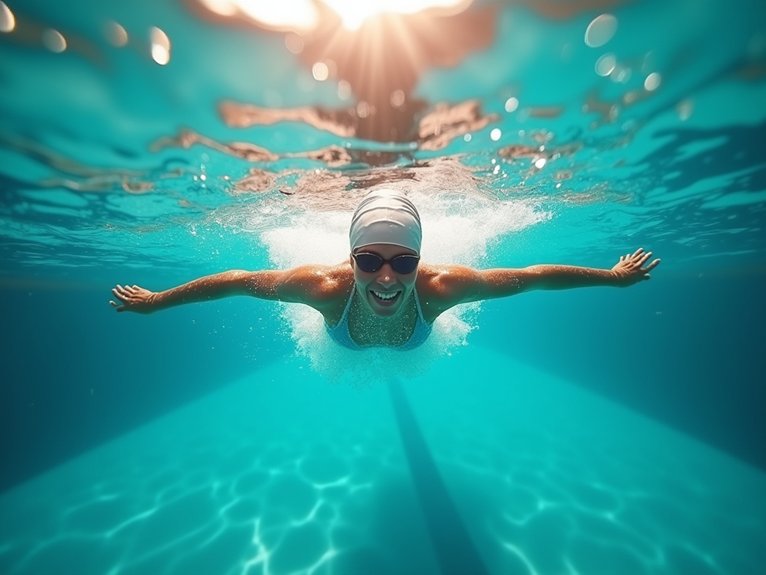Learning to swim starts with mental preparation and acknowledging fear as natural. Beginners should find a certified instructor who understands anxiety management and practice in warm, shallow pools. Essential skills include mastering breathing techniques like bubble blowing and rhythmic patterns, developing proper floating positions, and gradually building stroke components without rushing. Starting with back floats before attempting front floats creates a foundation of confidence. These fundamentals establish the pathway to swimming proficiency.
Overcoming Water Fear: Mental Preparation Strategies

A significant barrier for many aspiring swimmers is the fear of water. This anxiety often stems from negative experiences or uncertainty about water safety. Mental preparation begins with acknowledging this fear as natural and common.
Visualization techniques help individuals imagine successful swimming experiences before entering water. Gradual exposure—starting in shallow areas while practicing controlled breathing—builds confidence systematically. Many find comfort in learning with a trusted instructor who understands anxiety management.
Positive self-talk replaces catastrophic thinking with realistic assessments of water safety. Setting small, achievable goals creates a foundation of success experiences that gradually diminish water-related fears.
Finding the Right Instructor and Swimming Environment
Finding the Right Instructor and Swimming Environment
Why does the selection of an appropriate instructor and swimming venue matter so much for beginners? The right instructor provides proper technique guidance, safety supervision, and personalized feedback critical for skill development. They create a supportive environment that builds confidence while ensuring safety.
Swimming venues vary markedly in temperature, depth, and crowd levels. Beginners benefit from warm, shallow pools with minimal distractions. Community centers often offer dedicated beginner sessions with appropriate supervision.
When selecting an instructor, verify their certification, teaching experience with beginners, and communication style. For venues, consider accessibility, cleanliness, and whether the facility accommodates learners with separate areas for practice.
Essential Breathing Techniques for Beginners

Mastering proper breathing techniques forms the cornerstone of swimming proficiency for beginners. Novice swimmers should start by practicing bubble blowing while standing in shallow water, exhaling steadily through the mouth or nose when face is submerged.
The rhythmic pattern of inhaling above water and exhaling underwater creates the foundation for all swimming strokes. Beginners benefit from side-breathing exercises, turning the head to one side while maintaining body alignment.
Instructors recommend practicing „bob and breathe” exercises near pool walls for support. This involves alternating between submerging and emerging to establish comfortable breathing patterns, gradually building confidence before attempting forward movement with coordinated breathing.
Mastering Body Position and Floating Skills
Mastering Body Position and Floating Skills
With breathing techniques established, proper body position forms the next building block in learning to swim effectively. Achieving horizontal alignment in water requires relaxing the body while extending from head to toe.
Beginners should practice floating on their back first, as breathing remains unobstructed. The starfish position—arms and legs spread wide—provides maximum stability. Front floating requires face submersion, integrating previously learned breathing skills.
To maintain proper position, swimmers should keep their head aligned with the spine, hips near the surface, and legs extended. Instructors recommend practicing at the pool’s edge initially, gradually moving toward independent floating as confidence builds.
Building Strength With Basic Stroke Progressions

Once swimmers have established comfort with floating and proper body position, they can progress to basic stroke movements that build essential muscle strength. These foundational movements include flutter kicks, arm circles, and rhythmic breathing exercises.
Beginners should practice each element separately before combining them. Start with supported kicking drills using a kickboard, then add isolated arm movements while standing in shallow water. As coordination improves, gradually integrate these components into complete strokes.
Regular practice of these progressions develops the specific muscle groups needed for efficient swimming. Focus on proper technique rather than speed, as correct form establishes patterns that prevent injury and enhance endurance.
Practical Water Safety Skills Every New Swimmer Should Know
While learning proper swimming techniques is essential, understanding fundamental water safety skills forms the cornerstone of any thorough swimming education.
New swimmers should master floating on their back, which provides critical rest during water emergencies. Additionally, treading water allows swimmers to maintain an upright position while keeping their head above water. Learning proper breathing techniques prevents panic in unexpected situations.
Swimmers must understand how to recognize dangerous conditions, including rip currents and deep water. Knowledge of pool rules, never swimming alone, and understanding personal limitations are equally important. For children, implementing touch supervision within arm’s reach guarantees immediate assistance when needed.



